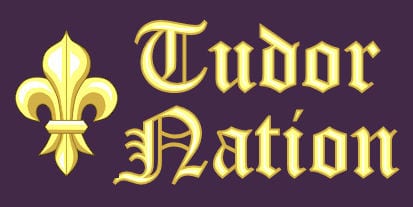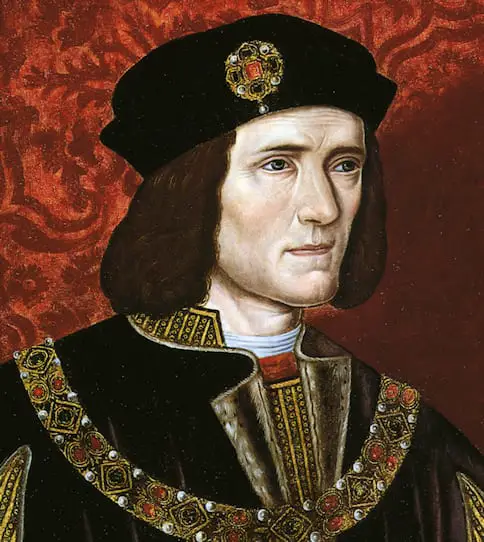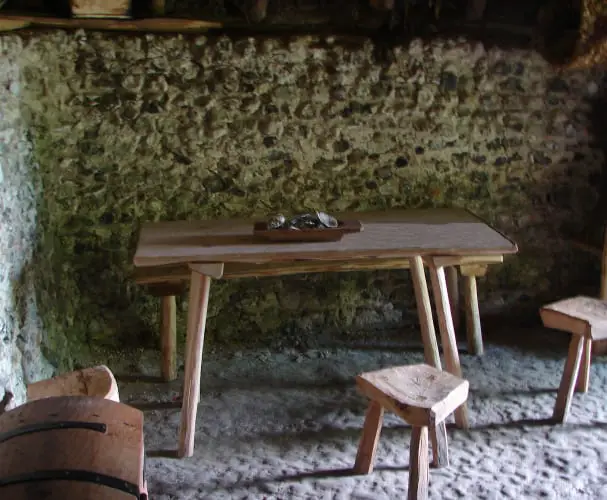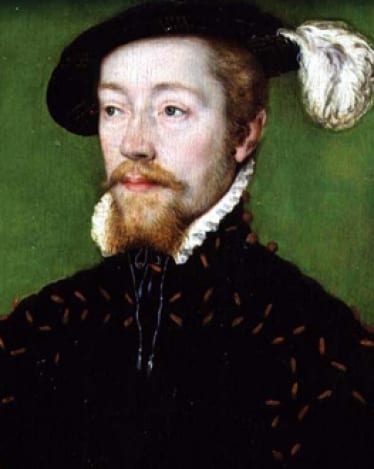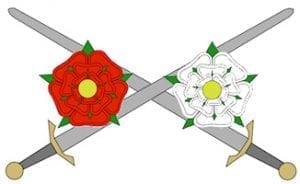
A chronology of Tudor Wars, Battles and Rebellions in the reign of Henry VII
10th October 1483
Buckingham’s Rebellion
The Duke of Buckingham rebelled against the rule of King Richard III’s. Henry Stafford, Duke of Buckingham, in favour of Henry Tudor, grandson of Henry V’s widow, Catherine of Valois.
1st August 1485
Henry Tudor’s Invasion
Henry Tudor left Harfleur, France at the head of an invasion force of French, Breton and Scottish soldiers.
7th August 1485
Henry Tudor’s Invasion
Henry Tudor landed at Milford Haven in Wales. He marched inland gaining much support along the way.
18th August 1485
King Richard Call to Arms
King Richard III called his army to muster at Leicester.
21st August 1485
Henry Tudor Made Camp
Henry Tudor’s army reached Whitemoor’s Plain near the town of Market Bosworth in Leicestershire and made camp.
22nd August 1485
Battle of Bosworth Field
Henry Tudor stood at the head of an army of around 5,000 men. Richard III’s army of around 9,000 men outnumbered the Tudor. The battle began in the morning and lasted for about two hours. The Earl of Oxford made a charge at Richard’s right flank and defeated the Duke of Norfolk. Richard then decided to charge directly at Henry. At this point, William Stanley, who had an army of 3,000 entered the on Henry Tudor’s side. The battle turned but Richard did not retreat, rather he chose to fight to the death. Henry was proclaimed King on the Battlefield.
January 1487
Lambert Simnel Rebellion
The Yorkists, who were opposed to the rule of Henry VII, put forward Lambert Simnel, the son of a tradesmen, as Edward, Earl of Warwick, the son of Richard III’s elder brother George. Margaret of Burgundy, Edward IV’s sister, backed Lambert Simnel.
2nd February 1487
Lambert Simnel Rebellion
Henry VII had placed the real Earl of Warwick in the Tower of London. To show that Lambert Simnel was an imposter he had the Earl paraded through the streets of London.
24th May 1487
Lambert Simnel Rebellion
Lambert Simnel was crowned King Edward VI in Christ Church, Dublin.
4th June 1487
Lambert Simnel Rebellion
Lambert Simnel landed near Furness and made his way towards York. The Earl of Lincoln had raised a large army in support of the pretender but the royalists in York called for Simnel to be surrendered.
16th June 1487
Battle of Stoke Field
Lambert Simnel’s army led by the Earl of Lincoln and John de la Pole attacked a royalist army led by the Earl of Oxford at Stoke Field near Newark. The Earl of Lincoln was killed and the rebels were defeated. The 11 year old Lambert Simnel was captured and set to work in the royal kitchens.
1489
Yorkshire Rebellion
Parliament granted Henry VII a tax of £100,000 to help Brittany maintain independence from France. Henry felt the money would buy him an ally in Brittany and also give him a base if he wished to take land from France.
Royal commissioners were appointed to collect the tax but they were given a hostile reception by the people. The hostility was particularly strong in Yorkshire and the Earl of Northumberland was murdered and York put under siege by rebels.
Henry had no choice but to raise an army to keep the rebellion contained. The recently released Earl of Surrey proved himself loyal to the Tudors by helping to put the rebellion down.
Royal commissioners were appointed to collect the tax but they were given a hostile reception by the people. The hostility was particularly strong in Yorkshire and the Earl of Northumberland was murdered and York put under siege by rebels.
Henry had no choice but to raise an army to keep the rebellion contained. The recently released Earl of Surrey proved himself loyal to the Tudors by helping to put the rebellion down.
November 1491
Perkin Warbeck Rebellion
Perkin Warbeck, an apprentice to a silk merchant, landed in Ireland where local people believed him to be Richard of York, son of Edward IV and rightful King of England. News of the appearance of the young Duke of York spread and Warbeck was invited to the court of his ‘aunt’ Margaret of Burgundy.
1492
Perkin Warbeck Rebellion
Perkin Warbeck, arrived at the court of Burgundy where Margaret of Burgundy acknowledged him as her nephew, Richard, the younger son of King Edward IV.
1492
Tariff War with Italy
Fixed tariffs were imposed by England on all Italian imports. The Italians retaliated by depriving English trading ships of a return cargo.
October 1492
Conflict with France
Henry sent a force to France to try to prevent King Charles VIII of France from annexing Brittany. The troops were unsuccessful so Henry crossed the Channel and invaded at the head of an army. Charles, having just secured Brittany, was reluctant to fight and agreed to negotiate for peace.
1493
Perkin Warbeck Rebellion
The pretender, Perkin Warbeck, was living regally in Antwerp as Richard Duke of York. He was in regular contact with his ‘aunt’ Margaret of Burgundy. Trade with Antwerp was sanctioned.
May 1494
Perkin Warbeck Rebellion
Henry VII imposed economic sanctions on the Holy Roman Emperor, Maximilian I, because he had recognised the claim of Perkin Warbeck to be the rightful King of England.
3rd July 1495
Perkin Warbeck Rebellion
Perkin Warbeck had mustered enough men to fill 14 ships, approximately 2,500 and anchored his ships off the coast of Deal in Kent. He sent a number of men to land in order to find out what support he could expect for a rebellion and takeover. Those that landed were captured by the Sheriff of Kent and Warbeck decided against an invasion and sailed to Ireland.
23rd July 1495
Perkin Warbeck Rebellion
Perkin Warbeck landed at Waterford in southern Ireland. There he lay siege to the traditionally Royalist city of Waterford.
3rd August 1495
Perkin Warbeck Rebellion
Warbeck abandoned the siege of Waterford and went to the city of Cork.
27th November 1495
Perkin Warbeck Rebellion
Perkin Warbeck landed in Scotland. He was given a state welcome by the Scottish King James IV.
early 1496
Perkin Warbeck Rebellion
Perkin Warbeck married Lady Catherine Gordon, daughter of a Scottish nobleman.
Summer 1496
England and the Netherlands
King Henry quarrelled with Philip of Burgundy after he disregarded the terms of Intercursus Magnus and placed an import duty on cloth.
21st September 1496
Perkin Warbeck Rebellion
James IV of Scotland crossed the border with a large army in support of Perkin Warbeck. He urged the northern counties of England to rise in rebellion against Henry VII but got little support.
25th September 1496
Perkin Warbeck Rebellion
James IV’s army in support of Perkin Warbeck returned to Scotland having failed to instigate a rebellion in the North of England. They mounted a raiding expedition on the way back to Scotland.
1497
Navy Increased
Two new ships, ‘The Sweepstake’ and ‘The Mary Fortune’ were built.
late May 1497
Cornish Revolt
The tax imposed by Henry to finance improving defences along the border with Scotland was resented by the men of Cornwall who felt that they were too far removed from the northern border for its defence to be their responsibility.
June 1497
Cornish Revolt
A band of Cornishmen led by Michael Joseph and Thomas Flamank began a march to London to petition the King. James Touchet, Baron Audley, was among the supporters that joined the revolt. Touchet soon became leader of the rebellion. Elizabeth and the royal children relocated to the Tower of London for safety and Henry dispatched a force to deal with the rebellion. After a brief skirmish the rebels changed route and marched to the historically rebellious county of Kent to try to gain more support.
17th June 1497
Cornish Revolt – Battle of Deptford Bridge
The band of rebels reached Kent but rather than finding support for their cause they were attacked at Deptford Bridge by a force raised by Lord Abergavenney, Earl of Kent. The rebels were routed and the three leaders captured.
5th July 1497
Perkin Warbeck Expelled from Scotland
Henry VII called for James IV to surrender Perkin Warbeck to England. He stated that James had broken the Anglo-Scots peace treaty and that if Warbeck were not expelled from Scotland the two countries would be at war. Ferdinand of Spain, fearful of an alliance between Scotland and France, instructed his ambassador to persuade James to comply with Henry’s wishes. James eventually realised that the alliance with England was in his best interests. He did not surrender Warbeck to England but instead provided him with a boat and told him to leave Scotland.
16th July 1497
Perkin Warbeck Rebellion
Perkin Warbeck accompanied by his wife and thirty loyal followers, landed in Cork to try to win support. They were well received by the Mayor of the city.
7th September 1497
Perkin Warbeck Rebellion
Perkin Warbeck landed at Whitesand near Land’s End in Cornwall. He hoped to utilise the unrest in Cornwall to gain support for his cause. He placed his wife in the monastery at St Michael’s Mount for her safety.
10th September 1497
Perkin Warbeck Rebellion
Perkin Warbeck was proclaimed King in Bodmin.
17th September 1497
Perkin Warbeck Rebellion
Warbeck had the backing of 8,000 peasants and lay siege to Exeter. However, they were beaten back with a loss of around 500 men.
20th September 1497
Perkin Warbeck Rebellion
Warbeck learned that a royal army led by D’Aubigny was stationed near Glastonbury.
21st September 1497
Perkin Warbeck Rebellion
In the early hours of the morning, Perkin Warbeck and a few trusted men left Cornwall for Southampton. They hoped to find a safe passage out of England. Instead they found a manned fleet in port awaiting their arrival. Warbeck had no choice but to flee.
4th October 1497
Perkin Warbeck Rebellion
The abandoned leaders of Perkin Warbeck’s army surrendered to Henry VII at Taunton. Warbeck deserted his army and fled east.
5th October 1497
Perkin Warbeck Rebellion
Perkin Warbeck was captured at Beaulieu Abbey. He confessed to being an imposter and begged forgiveness.
Summer 1499
Claimants to the Throne
Catherine of Aragon’s father, Ferdinand, expressed concern that his daughter Catherine may not every become Queen while other claimants to the throne remained alive.
Summer 1499
Edmund de la Pole Fled to Calais
Edmund de la Pole, Earl of Suffolk, eldest surviving son of Edward IV’s sister, Elizabeth, fled to Calais. He feared for his life after Ferdinand of Aragon expressed concern about the number of pretenders to the English throne.
First published 2017; updated and re-published Jul 27 2020 @ 8:05 pm – Updated –
Harvard Reference for this page:
Heather Y Wheeler. (2017 – 2021). Tudor Wars Battles and Rebellions Chronology Available: https://www.tudornation.com/tudor-wars-battles-and-rebellions-chronology Last accessed [date]
